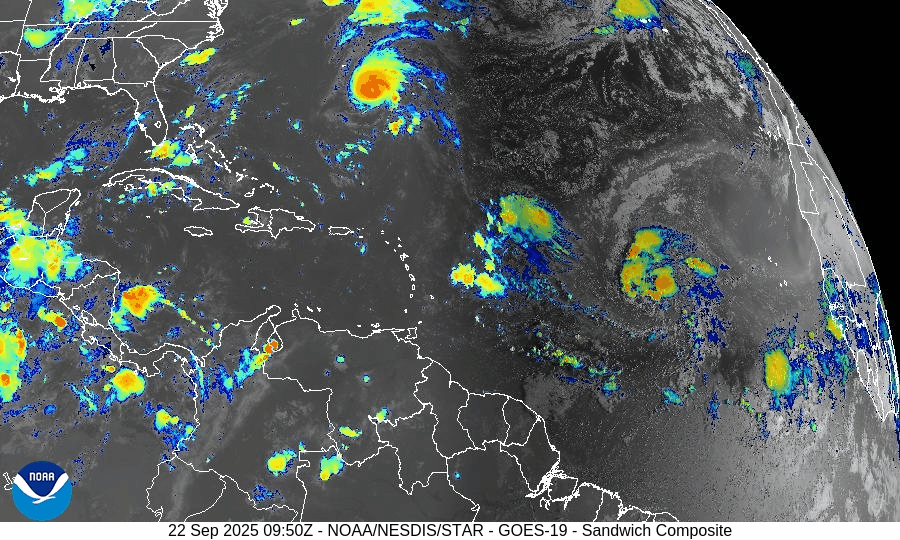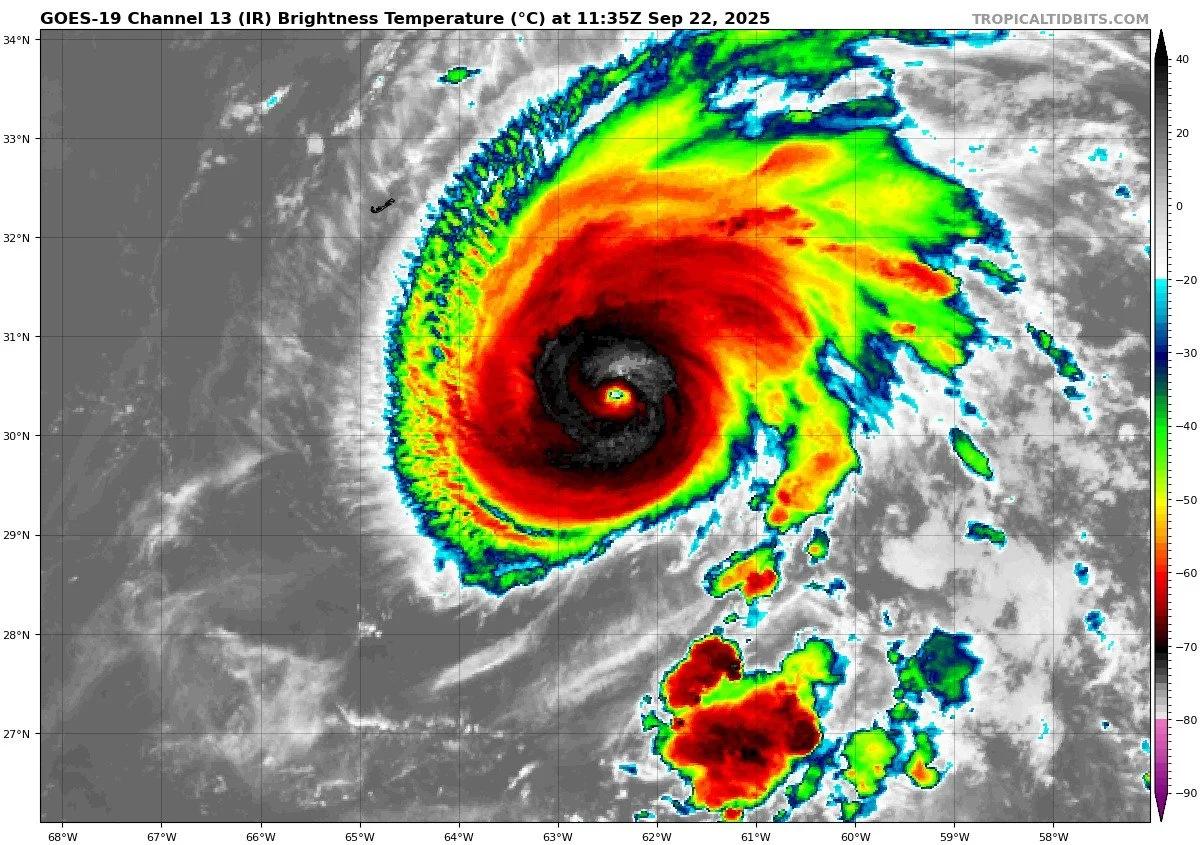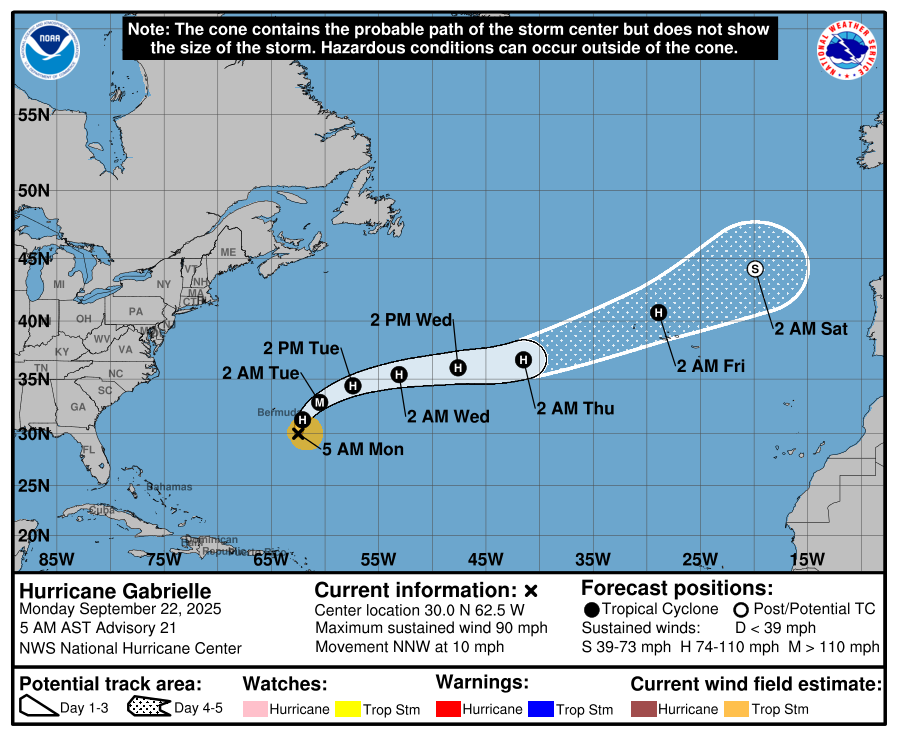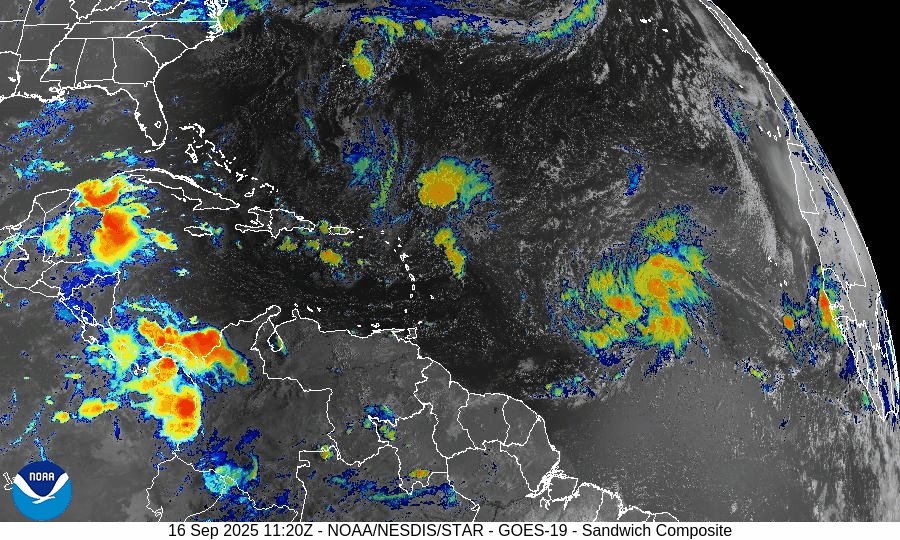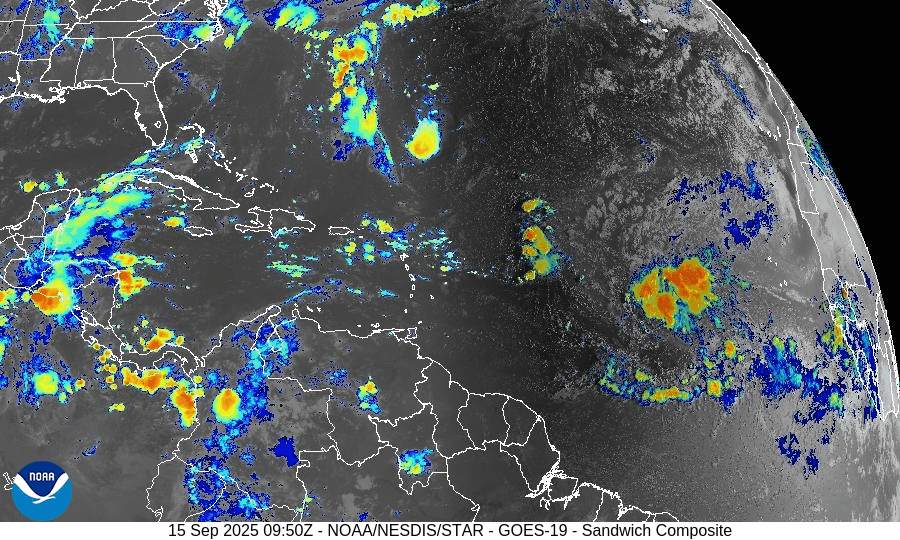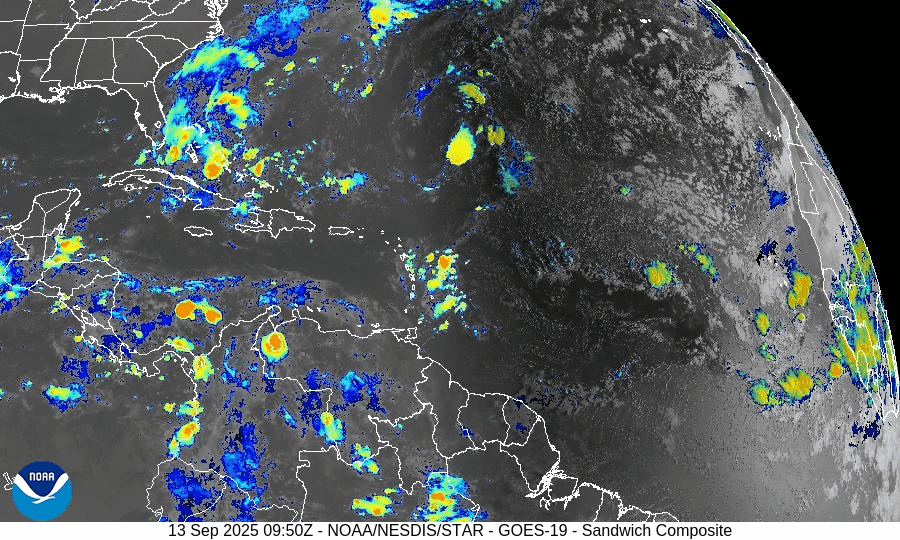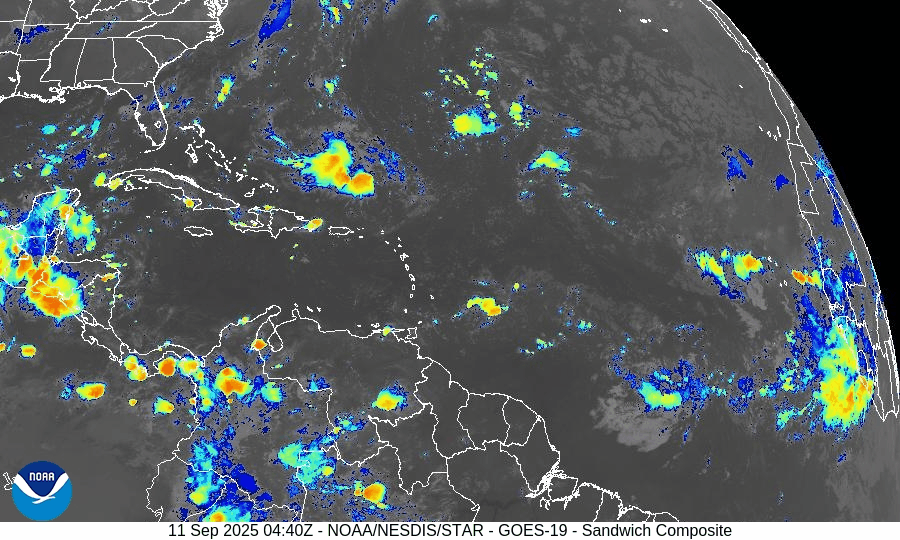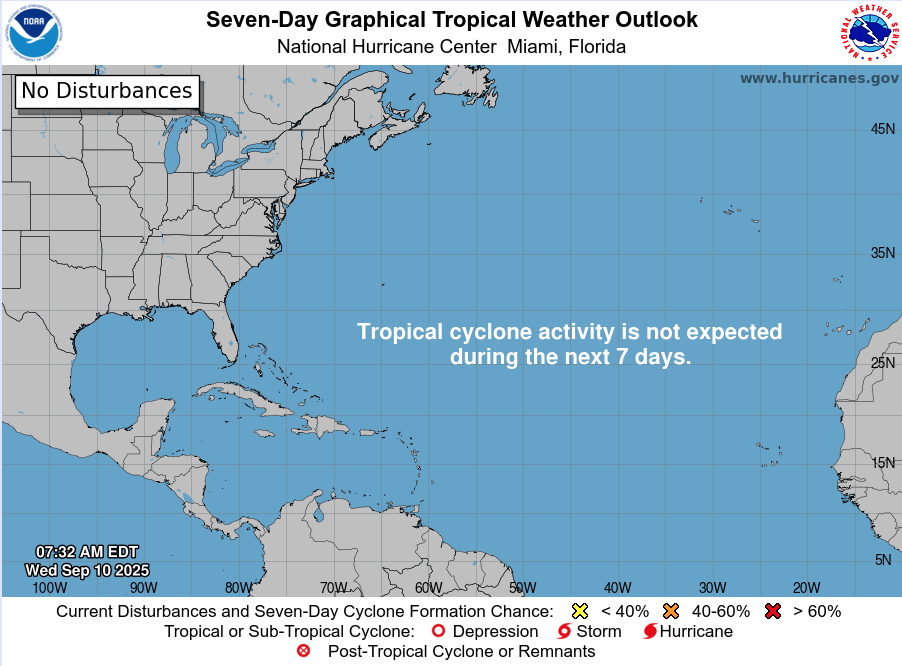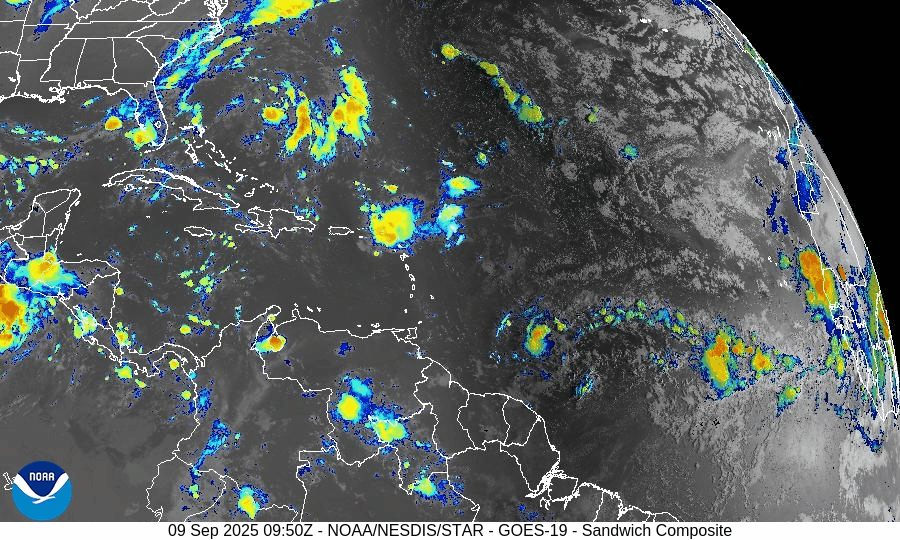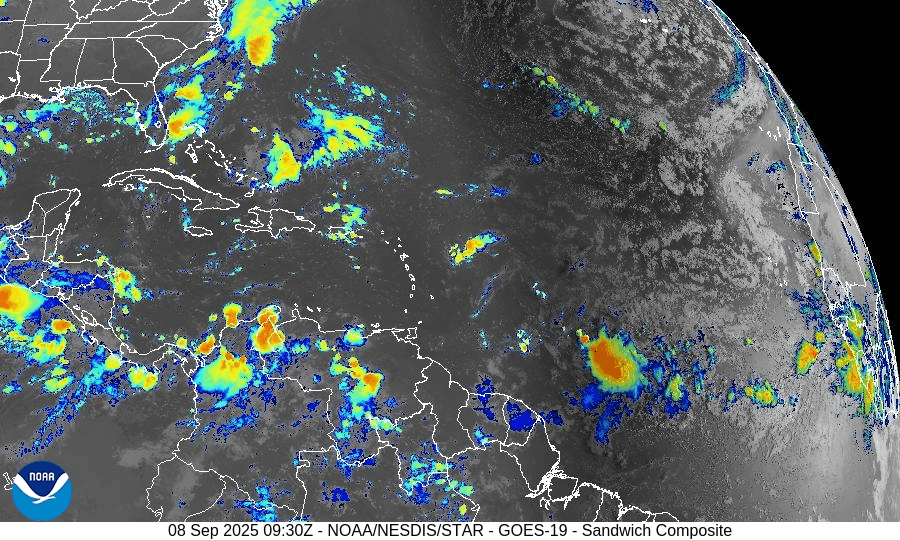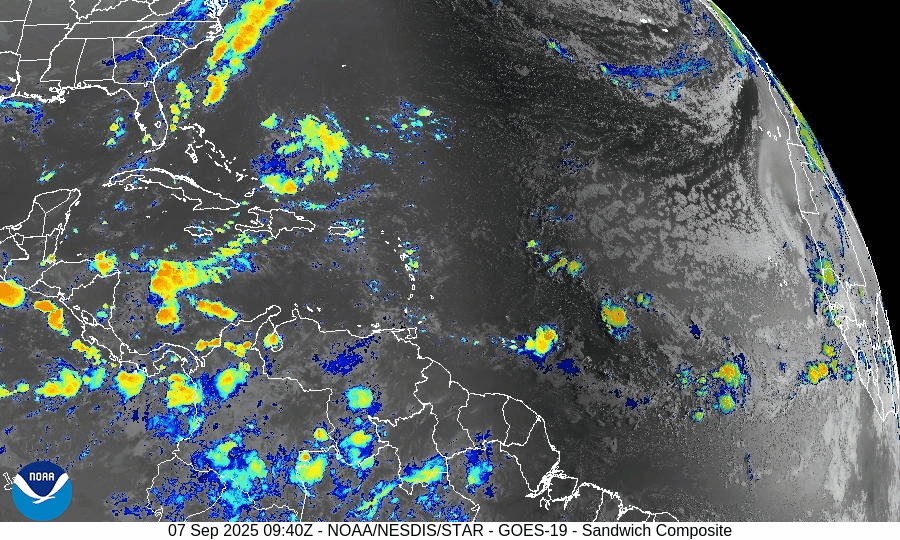Atlantic Hurricane Outlook – September 22, 2025
On September 22, Hurricane Gabrielle is active in the central Atlantic as a Category 1 storm with sustained winds near 90 mph. The storm is forecast to pass east of Bermuda, producing no direct land impacts but generating strong swells and rip currents. Two additional tropical waves are being monitored, with one given a 60% chance of development over the next week. Florida and the Gulf of America remain calm, experiencing only routine late-summer thunderstorms.
Hurricane Gabrielle strengthens; two additional waves being monitored
Atlantic Basin Overview
Hurricane Gabrielle
Gabrielle has intensified into a Category 1 hurricane, currently located southeast of Bermuda. Sustained winds are near 90 mph, and the storm is moving north-northwest at about 10 mph. Forecasts suggest further strengthening is possible over the next day or two. On its current track, Gabrielle is expected to pass east of Bermuda, with no direct landfall threat at this time.
Other Tropical Waves / Disturbances
The National Hurricane Center is monitoring two tropical waves across the Atlantic. One has a 60% chance of development over the next 7 days. Current model guidance suggests both systems are likely to stay over open waters or curve northward before approaching the Eastern U.S. coastline, including Florida, the Carolinas, and the Mid-Atlantic.
At this stage, no direct impacts are expected along the Eastern Seaboard, though stronger swells could increase rip current risks later in the week.
Environmental Conditions
Sea Surface Temperatures (SSTs): SSTs in the central to western tropical Atlantic remain warm—sufficient to support further strengthening of Gabrielle.
Wind Shear: Wind shear and dry air (including influence from the Saharan Air Layer) are suppressing organization in some quadrants of Gabrielle, slowing structural improvement.
Eastern Waves: The waves being monitored farther east are in less favorable environments currently—strong shear, dry air, and reduced moisture are limiting immediate development.
Gulf of America & Caribbean
The Gulf of America and Caribbean remain calm. High pressure dominates, producing only scattered afternoon thunderstorms. No organized tropical development is expected in these regions.
Florida & Eastern U.S. Forecast
Florida and the broader Eastern U.S. coastline remain outside of any direct tropical threats from Gabrielle or the monitored waves. Expect late-September conditions: warm, humid, with scattered afternoon thunderstorms. Swells from Gabrielle could enhance surf and rip current risks along parts of the East Coast later this week.
Rain forecast visualization courtesy of Windy.com
Summary
Gabrielle is now a Category 1 hurricane, strengthening in the central Atlantic, forecast to pass east of Bermuda.
Two tropical waves have been flagged; one has 60% development odds over 7 days, though no U.S. impacts are expected at this time.
Environmental factors favor Gabrielle’s gradual strengthening but suppress development of the eastern waves.
Gulf of America, Florida, and the Eastern Seaboard remain calm, with no direct tropical threats currently.
TL;DR – September 22 Snapshot
Hurricane Gabrielle is a Category 1, staying offshore and east of Bermuda.
Two waves being monitored; one with 60% odds, no U.S. threat expected.
Warm SSTs support Gabrielle; wind shear, dry air, and SAL limit other development.
Florida and the Eastern U.S. coast remain safe for now, aside from potential rip current risks.
Atlantic Hurricane Outlook – September 16, 2025
On September 16, Invest 92L in the central Atlantic continues to organize and has a 90% chance of becoming a tropical depression or Tropical Storm Gabrielle in the next 48 hours. Another tropical wave is emerging off Africa with a lower 20% chance of development over 7 days. While warm waters and reduced wind shear support 92L’s growth, dry air and Saharan dust continue to hinder the African wave. Florida and the Gulf remain calm with only typical late-summer storms.
Invest 92L likely to become Tropical Storm Gabrielle; new wave off Africa also being monitored
Atlantic Basin Overview
Invest 92L
A broad area of low pressure known as Invest 92L—located about midway between the Windward Islands and the coast of West Africa—is showing increasing organization. The National Hurricane Center indicates high odds (≈ 90%) of formation into a tropical depression or tropical storm within the next 48 hours and similarly high odds over a 7-day outlook. Forecasts suggest it will move west-northwest or northwest at 10-15 mph. If named, it will be called Gabrielle.New Tropical Wave Off Africa
Another tropical wave is emerging off the western coast of Africa. It has lower odds of development—roughly 20% over 7 days, and near zero in the next 48 hours. It is moving westward toward the central Atlantic, where conditions could improve for gradual organization.
Environmental Conditions
Sea Surface Temperatures (SSTs): SSTs remain warm in the central to western tropical Atlantic, supportive of tropical storm development for disturbances like Invest 92L.
Wind Shear: The upper-level wind shear is decreasing in regions around Invest 92L, aiding its organization. However, moderate shear still exists in other parts of the basin, especially for newer waves emerging off Africa.
Dry Air & Saharan Air Layer (SAL): Dry air and dust from the Saharan Air Layer remain present in parts of the eastern Atlantic, which is damping convection in the newer wave. For Invest 92L, moisture levels are improving, helping its organizational efforts.
Gulf of America (Mexico) & Caribbean
The Gulf of Mexico and Caribbean remain mostly quiet. High pressure dominates, and while afternoon thunderstorms remain routine, no tropical development is expected in these regions in the near term.
Florida & Southeast U.S. Forecast
Florida is under its normal mid-September weather pattern—hot, humid, with scattered afternoon storms. There is no immediate tropical threat to Florida from Invest 92L or the wave off Africa at this time, though residents should monitor forecasts in case the track changes.
Rain forecast visualization courtesy of Windy.com
Summary
Invest 92L is very likely to become Tropical Storm Gabrielle imminently, with high chances over the next 1-2 days.
A new wave off Africa has low development odds now but could gain strength later in the week.
Environmental factors (warm SSTs, easing shear, improving moisture) favor development of Invest 92L, though SAL and dry air still affect newer disturbances.
Gulf, Caribbean, and Florida remain calm with only routine summer weather expected.
TL;DR – September 16 Snapshot
Invest 92L expected to form soon (likely Tropical Storm Gabrielle) with ~90% odds.
New wave off Africa has modest (~20%) 7-day potential.
Conditions are increasingly favorable around Invest 92L.
No tropical threats to Florida or the U.S. currently; routine summer storms only.
Atlantic Hurricane Outlook – September 15, 2025
On September 15, the Atlantic remains without active storms, but attention is on a tropical wave in the central Atlantic. The National Hurricane Center gives it a 30% chance of development in 48 hours and 80% over 7 days. Warm waters and easing wind shear may support gradual organization, while dry air and Saharan dust continue to limit rapid strengthening. Florida and the Gulf remain calm, with only routine heat, humidity, and scattered thunderstorms.
Quiet Atlantic continues; a tropical wave off western Africa showing high 7-day development potential
Atlantic Basin Overview
No Active Tropical Cyclones
The Atlantic, Gulf of Mexico, and Caribbean remain storm-free. The National Hurricane Center confirms there are no tropical storms or hurricanes currently active.Tropical Wave in the Central Tropical Atlantic
A tropical wave located in the central tropical Atlantic is producing a large area of disorganized showers and thunderstorms. It is moving west-northwest at 10-15 mph, and environmental conditions are expected to permit gradual development through the week. Formation chances are about 30% over the next 48 hours, increasing to 80% over the next 7 days.
Environmental Conditions
Sea Surface Temperatures (SSTs): SSTs in the tropical Atlantic remain warm enough to support storm formation.
Wind Shear: Moderate shear is present; while it may hinder rapid intensification early on, shear is expected to diminish somewhat near the wave’s path.
Dry Air & Saharan Air Layer (SAL): Dry air and some SAL/ dust intrusions are observed over parts of the eastern Atlantic. These will likely slow initial development but are not expected to completely prevent it as moisture pickup increases.
Gulf of America (Mexico) & Caribbean
The Gulf remains quiet under high pressure. Only routine afternoon and marginal overnight thunderstorms are forecast along coastal zones. No systems are showing organization or threat. Seas are generally modest.
Florida & Southeast U.S. Forecast
Florida is continuing its typical mid-September pattern: hot, humid, with scattered afternoon storms driven by sea breezes. With no tropical systems nearby, there are no tropical threats expected this week. Marine conditions are moderate and normal for this time of year.
Rain forecast visualization courtesy of Windy.com
Summary
The Atlantic remains calm with no active storms.
A tropical wave in the central Atlantic shows high potential (80% over 7 days) to develop, possibly forming a depression by week’s end.
Environmental factors (warm SSTs, reducing shear, some dry air) are mixed—some favorable, some limiting.
Gulf, Caribbean, Florida remain quiet with routine weather patterns.
TL;DR – September 15 Snapshot
Atlantic is quiet; no active systems.
The central tropical Atlantic wave has ~80% 7-day development odds.
Conditions are marginal but becoming more favorable near the wave.
Florida/Gulf remains calm with only the usual summer storms.
Atlantic Hurricane Outlook – September 13, 2025
On September 13, the Atlantic basin remains storm-free, with no tropical cyclones currently active. A tropical wave between Africa and the Cabo Verde Islands is producing showers and thunderstorms but faces limited short-term development potential due to dry air and wind shear. The Gulf of Mexico and Florida remain calm, experiencing only the usual heat, humidity, and afternoon storms of late summer.
Atlantic basin quiet; tropical wave off Africa flagged, but development odds remain modest
Atlantic Basin Overview
No Active Tropical Cyclones
There are currently no tropical storms, hurricanes, or depressions in the Atlantic, Gulf of Mexico, or Caribbean. The NHC confirms the basin is calm with no active systems.Tropical Wave Near Africa / Cabo Verde Islands
A tropical wave located between the west coast of Africa and the Cabo Verde Islands is producing some showers and thunderstorms. It’s being monitored. Environmental conditions (dry, stable air) are expected to limit development over the next few days, though a tropical depression could form by the middle to latter part of next week, moving west-northwestward at ~10-15 mph.
Environmental Conditions
Sea Surface Temperatures (SSTs): Warm in the Caribbean and Gulf (~29–31 °C), but the far eastern Atlantic faces somewhat cooler and less supportive SSTs for strong development.
Wind Shear: Moderate to strong upper-level wind shear persists, especially over the regions east of the tropical wave, making rapid intensification unlikely.
Dry Air & Saharan Air Layer (SAL): Significant dry and stable air, partly from the SAL, remains present over much of the eastern and central Atlantic — this is suppressing convective organization in the tropical wave.
Gulf of (America) Mexico & Caribbean
Both regions remain calm under high pressure. Only typical afternoon sea-breeze thunderstorms are occurring. There are no disturbances showing signs of organization in the Gulf or Caribbean.
Florida & Southeast U.S. Forecast
Florida continues with late-summer conditions: hot, humid, with scattered afternoon showers and thunderstorms. With no nearby tropical systems, there are no tropical threats or enhanced coastal risks at this time. Marine conditions are benign.
Rain forecast visualization courtesy of Windy.com
Summary
Atlantic basin remains inactive; no active systems.
A tropical wave off Africa is being monitored; development is possible later in the week but odds are modest and hindered by dry air and shear.
Environmental conditions are generally unfavorable for strong or rapid development in the near term.
Gulf, Caribbean, and Florida see only routine seasonal weather—no tropical threats.
TL;DR – September 13 Snapshot
Atlantic quiet—no storms active.
Tropical wave near Africa has potential but low short-term chances.
Dry air, SAL, and shear continue to suppress activity.
Florida & Gulf remain calm, with typical heat and scattered storms.
Atlantic Hurricane Outlook – September 11, 2025
On September 11, the Atlantic basin remains storm-free with no active cyclones. A tropical wave emerging off the coast of Africa has been given a 30% chance of development over the next 7 days, though environmental conditions such as wind shear, dry air, and Saharan dust remain unfavorable. The Gulf of Mexico and Florida stay calm, experiencing only typical late-summer thunderstorms.
Atlantic remains calm; weak tropical wave off Africa flagged with low chance (30%) of development over 7 days
Atlantic Basin Overview
No Active Tropical Cyclones
The Atlantic basin, including the Caribbean Sea and Gulf of Mexico, currently has no active tropical storms, hurricanes, or depressions. The NHC outlook confirms no formation expected in the near term.Tropical Wave Off Africa
A tropical wave is forecast to emerge offshore of West Africa by Friday. It will travel west to west-northwest at about 15 mph, over the eastern and central tropical Atlantic. Although conditions may allow for some gradual development, the NHC gives this wave a low chance (near 0%) over the next 48 hours, increasing to 30% over the next 7 days.
Environmental Conditions
Sea Surface Temperatures (SSTs): Warm in the Gulf and Caribbean (29–31 °C), supportive for storm formation there—but in the eastern tropical Atlantic, SSTs are marginal or just adequate for potential development.
Wind Shear: Moderate to high shear persists across much of the Atlantic, making rapid development unlikely.
Dry Air & Saharan Air Layer (SAL): Dry mid-level air and SAL remain strong headwinds for storm formation, especially for any tropical waves nearing the eastern Atlantic.
Gulf of America (Mexico) & Caribbean
Conditions remain quiet and stable. Only routine afternoon thunderstorms are expected along coastal areas, with no tropical system showing signs of organization.
Florida & Southeast U.S. Forecast
Florida continues in its typical early-September weather pattern—hot, humid, and marked by scattered afternoon thunderstorms. With no active systems in the Atlantic, Gulf, or nearby, there are no coastal or tropical threats expected in the short term. Surf and marine conditions are generally benign.
Rain forecast visualization courtesy of Windy.com
Summary
Atlantic is quiet with no active tropical storms.
Weak tropical wave off Africa has ~30% chance of development in 7 days; 0% in the next 48 hours.
Environmental factors (SSTs, shear, dry air/SAL) remain mostly unfavorable.
Gulf and Florida remain calm with routine summer convection.
TL;DR – September 11 Snapshot
No active storms in the Atlantic.
Wave off Africa has low but nonzero chance (30%) of forming in the coming days.
Hostile environment limits quick growth.
Florida and Gulf: quiet, typical late-summer weather.
Atlantic Hurricane Outlook – September 10, 2025
On September 10, the Atlantic basin remains calm despite being the statistical peak of hurricane season. No tropical cyclones are active, and the National Hurricane Center does not expect development over the next week. Dry air, Saharan dust, and wind shear are keeping conditions hostile to storm formation. Florida and the Gulf of Mexico remain quiet, with only the typical late-summer pattern of heat, humidity, and afternoon thunderstorms.
Atlantic remains exceptionally calm during climatological peak; no tropical development expected
Atlantic Basin Overview
No Active Systems
Despite reaching the climatological peak of hurricane season (September 10), the Atlantic basin remains completely quiet—no tropical depressions, storms, or hurricanes are present. The National Hurricane Center’s 7-day outlook again shows no expected development.
The season's accumulated cyclone energy (ACE) across the Northern Hemisphere is currently below 60% of average, further emphasizing the unusual lull.
Last week’s disturbance—once showing high development potential near the Caribbean—dissipated after ingesting dry, dusty air from the Sahara.
Environmental Conditions
Sea Surface Temperatures (SSTs): Subtropics indicate record-warm SSTs, while much of the tropical Atlantic remains cooler than last year, reducing atmospheric instability and suppressing storm formation.
Atmospheric Conditions: Saharan dust plumes and a notably weak lapse rate in the atmosphere continue to inhibit convective development across the basin.
Looking Ahead: Meteorologists anticipate that activity may increase from late September into October. This is driven by the expected arrival of the Madden-Julian Oscillation (MJO) and continuing La Niña trends, both of which tend to support tropical cyclone development.
Gulf of Mexico & Caribbean
No tropical threats are present. High-pressure dominance continues to maintain calm conditions, aside from normal afternoon sea-breeze thunderstorms.
Florida & Southeast U.S. Forecast
Florida remains in its typical late-summer pattern: hot, humid, with scattered afternoon storms. With no tropical systems in the Atlantic or Gulf, no coastal or tropical hazards are expected this week.
Rain forecast visualization courtesy of Windy.com
Summary
The Atlantic basin is quiet, with no storms active or expected over the next 7 days.
Suppressive factors—cooler SSTs, dry air, Saharan dust, and weak atmospheric instability—continue to dominate.
Although conditions are currently unfavorable, model and observational insights suggest a potential pickup in tropical activity later this month as MJO and La Niña factors emerge.
Gulf and Florida remain unaffected, encountering only routine late-summer weather.
TL;DR – September 10 Snapshot
No activity in the Atlantic—still quiet at hurricane season peak.
Atmospheric conditions strongly suppress development: dry air, dust, and cool SSTs.
Climatology points to a possible uptick in activity toward late September/October.
Florida and the Gulf stay quiet—just the usual stormy afternoons.
Atlantic Hurricane Outlook – September 9, 2025
TLDR Version: Click Here
Atlantic remains unusually quiet during peak season; no tropical development expected
Atlantic Basin Overview
No Active Storms
The Atlantic basin continues to be completely quiet. The National Hurricane Center’s latest outlook indicates no tropical cyclone formation is expected in the next 7 days.Tropical Waves
Although a few tropical waves are present, none show signs of sustained convection or development, remaining inactive across the Atlantic. This is stark, given we're in what is normally the most active week of the season.
Environmental Conditions
Sea Surface Temperatures (SSTs): Warm in the Gulf and Caribbean (~29–31 °C), but less conducive further east.
Wind Shear: Elevated shear across the basin continues to suppress tropical formation.
Dry Air & SAL: Persistent dry air and Saharan dust remain widespread, further choking off storm development.
Gulf of Mexico & Caribbean
Conditions remain stable and calm. Only typical afternoon sea-breeze thunderstorms are present along coastal areas. No tropical systems are forecast.
Florida & Southeast U.S. Forecast
Florida continues in its late-summer pattern: hot, humid, with scattered afternoon thunderstorms. With no systems nearby and improving surf conditions, there are no coastal or tropical threats expected this week.
Summary
The Atlantic is fully quiet with no active storms or development expected.
This is unusual for the second week of September, historically known as the Hurricane Season peak.
Environmental conditions remain unfavorable for storm formation: wind shear, dry air, and SAL dominate.
Gulf and Florida remain calm, experiencing only routine weather patterns.
TL;DR – September 9 Snapshot
No storms or development expected; Atlantic remains at rest.
Tropical waves are inactive amid unfavorable conditions.
Environmental factors continue to suppress activity.
Florida and the Gulf stay consistent with typical late-summer weather.
Atlantic Hurricane Outlook – September 8, 2025
On September 8, the Atlantic remains storm-free with no tropical systems active. Two weak tropical waves are producing scattered showers but lack organization, and the National Hurricane Center expects no development over the next week. Florida and the Gulf of Mexico remain calm, experiencing only the usual late-summer heat, humidity, and afternoon thunderstorms.
TLDR Version: Click Here
Atlantic basin remains calm — no tropical development expected this week
Atlantic Basin Overview
No Active Systems
The Atlantic, Caribbean, and Gulf of America (Mexico) remain free of tropical cyclones. The National Hurricane Center does not expect any development over the next 7 days.
Tropical Waves Present but Inactive
A wave near 20°W, east of the Cabo Verde Islands, is producing scattered showers but is not expected to organize.
Another wave between 41°W and 47°W in the central Atlantic shows some convection but remains disorganized.
Environmental Conditions
Sea Surface Temperatures (SSTs): Warm in the Gulf and Caribbean (~29–31 °C), but cooler in the open Atlantic, limiting storm growth.
Wind Shear: Moderate to strong across much of the basin, unfavorable for storm organization.
Dry Air & SAL: The Saharan Air Layer and widespread dry mid-level air continue to suppress deep convection and tropical development.
Gulf of America (Mexico) & Caribbean
The Gulf remains quiet and stable, with only routine afternoon sea-breeze thunderstorms. No tropical development is expected.
Florida & Southeast U.S. Forecast
Florida stays in its late-summer pattern of heat, humidity, and scattered afternoon thunderstorms. No tropical threats are present this week.
Rain forecast visualization courtesy of Windy.com
Summary
The Atlantic is inactive, with no storms or new development expected.
Two tropical waves are noted, but neither shows potential for near-term organization.
Environmental conditions remain unfavorable across the basin, with shear, dry air, and SAL dominating.
The Gulf and Florida remain calm, with only routine late-summer weather.
TL;DR – September 8 Snapshot
No storms in the Atlantic.
A couple of weak tropical waves, but no organization.
Shear, dry air, and SAL continue to suppress development.
Gulf and Florida remain quiet with typical afternoon thunderstorms.
Atlantic Hurricane Outlook – September 7, 2025
On September 7, the Atlantic remains completely calm with no tropical storms or hurricanes. The National Hurricane Center expects no development over the next 7 days. A weak tropical wave in the central Atlantic is producing scattered showers but shows no signs of organization. Florida and the Gulf of Mexico remain quiet, experiencing only typical late-summer thunderstorms.
**We’re back after a series of technical issues. We apologize for the inconvenience.
TLDR Version: Click Here
Atlantic remains quiet with no tropical development expected in the next week
Atlantic Basin Overview
No Active Storms
The Atlantic basin is completely calm—no tropical depressions, storms, or hurricanes are present. The NHC advises that no tropical cyclone formation is expected over the next seven days.Tropical Waves Noted
A central Atlantic wave near 41°W and 17°N, moving west at 10–15 kt, shows scattered moderate convection—but no sign of imminent development.
Environmental Conditions
Sea Surface Temperatures (SSTs): Still warm across the Gulf and Caribbean (~29–31 °C), but less favorable in the open Atlantic.
Wind Shear: Elevated winds aloft continue across the basin, suppressing convective organization.
Mid-Level Humidity & SAL: Dry air and Saharan dust remain widespread, further limiting storm initiation.
Gulf of Mexico & Caribbean
The Gulf remains quiet and stable, with only typical afternoon sea-breeze thunderstorms occurring along coastal areas. No tropical systems are expected to develop.
Florida & Southeast U.S. Forecast
Florida continues under a late-summer pattern—hot, humid, and featuring scattered afternoon thunderstorms. With no systems nearby and improving sea conditions, no enhanced coastal risks are currently expected.
Rain forecast visualization courtesy of Windy.com
Summary
The Atlantic basin remains quiet, with no active systems or expected development in the short term.
Although tropical waves are present, environmental factors (warm SSTs excluded) are largely unfavorable across the basin.
The Gulf and Florida remain unaffected, experiencing only routine summertime weather.
TL;DR – September 7 Snapshot
No storms in the Atlantic; no development expected for 7 days.
A wave in the central Atlantic shows no signs of imminent organization.
Environmental factors continue to suppress new tropical formation.
Florida and Gulf remain calm with only routine weather patterns.

